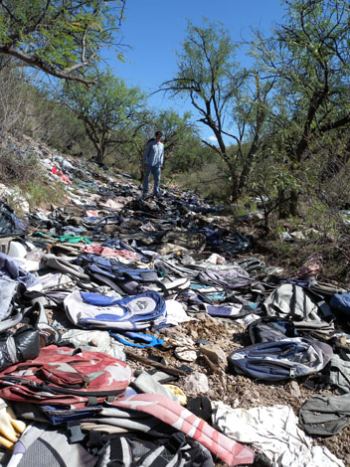The issue is not The Things They Carried, but the things they left behind. University of Washington’s Jason De Leon is building a portrait of Latinos who try to slip into the U.S. without benefit of passport. He’s creating it from what they are forced to drop on their way: backpacks, water bottles, shirts, jackets, photos, toys and shoes.
 Shoes are especially ominous. Where do they go without them?
Shoes are especially ominous. Where do they go without them?
De Leon has collected at sites around the Mexican border in
his work to better understand one of the world’s largest ongoing
modern-day migrations–the exodus of millions of Latinos into the United
States.
More than half a million immigrants attempt to cross the border in
southern Arizona each year…While this phenomenon is often debated and
argued about, the process of migration has attracted little rigorous
academic attention. (more)
Until
now. De Leon’s Undocumented Migration Project (UMP) uses
anthropology to decode a mystery obscured by politics and passion, the
human cost of a boundary created by historical illusion. The land a
people once owned is denied to them, and they, now called illegal immigrants,
are intruders.
A few days after 9/11, Sherman Alexie was walking on a Seattle street when a pickup truck festooned with American flags pulled over. The white driver rolled down his window and yelled at him to go home, presumably mistaking him for someone of Middle Eastern ethnic origin.
“You first,” the Spokane/Coeur d’Alene
Indian writer thought to say after the truck had sped away. People who hurl insults out of windows rarely wait for a reply.
The Mexican town of Alberto is building a simulated border-crossing theme park:
Seven hours south of the US/Mexican Border lies the small town of Alberto, where the local community, like many pueblos across Mexico, has lost 80 percent of its population to migration into the United States. But Alberto has a plan to revive their community, the creation of a theme-park event – a simulated border crossing, complete with balaclava-clad “coyotes” as guides and “border patrol” that chase “migrants” up and down rough terrain through the night. They call this event the Caminata (translation: journey, hike, trek). The organizers designed the experience as a tool for compassion and consciousness-raising, showing the largely middle-class Mexican tourists who attend the difficulty and dangers faced by those crossing the border. (Watch movie here.)
Also related: Guillermo Gomez Pena’s La Pocha Nostra, via. Writes Gomez Pena:
La Pocha Nostra is by nature anti-essentialist and anti-nationalist. We claim an extremely unpopular position in post-9/11 U.S. “No homeland; no fear; no borders; no patriotism; no nation-state; no ideology; no censorship”….Our America is still an open society with porous borders; our America is neither “Red” nor “Blue;” it is brown, black, yellow, pink and transparent. Always.
(Thanks to Jackie Goodrich for the link to Jason De Leon.)
Update: Although there is credit given on the links, some of those involved in the referenced story in the University of Washington’s Alumni Magazine, Columns, feel that credit needs to be more specific. To wit: The Anthropology of Garbage was written by Jeff Bond with photos by Jeff Corwin. At Corwin’s request, I deleted his photos.



Artist Judy Werthein:
Cross-trainers for Immigrants:
The Shoes
My parents live southeast of San Diego along an immigrant trail. When we visit we tend to collect the debris along the trail (the saddest being stuffed animals and toys). It’s mainly backpacks water bottles and clothes.
Basically, the back pack contains a change of clean clothes. The immigrants change right before they’re picked up at a predesignated spot. That way if you’re pulled over it doesn’t look like you’ve been walked 15 miles through the brush.
Thanks for introducing me to Jason’s work.
Countries exist. They are entitled to secure their borders. You can’t go back into history and hope to find justification for letting anybody in. Two wrongs do not make rights.
http://news.bbc.co.uk/2/hi/americas/4445342.stm